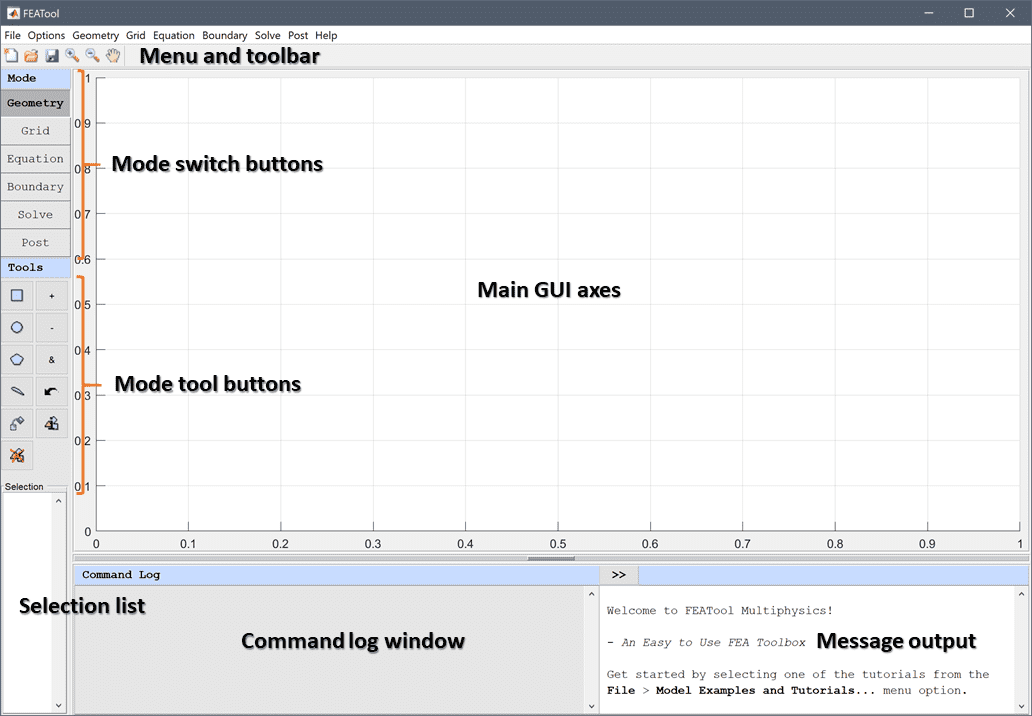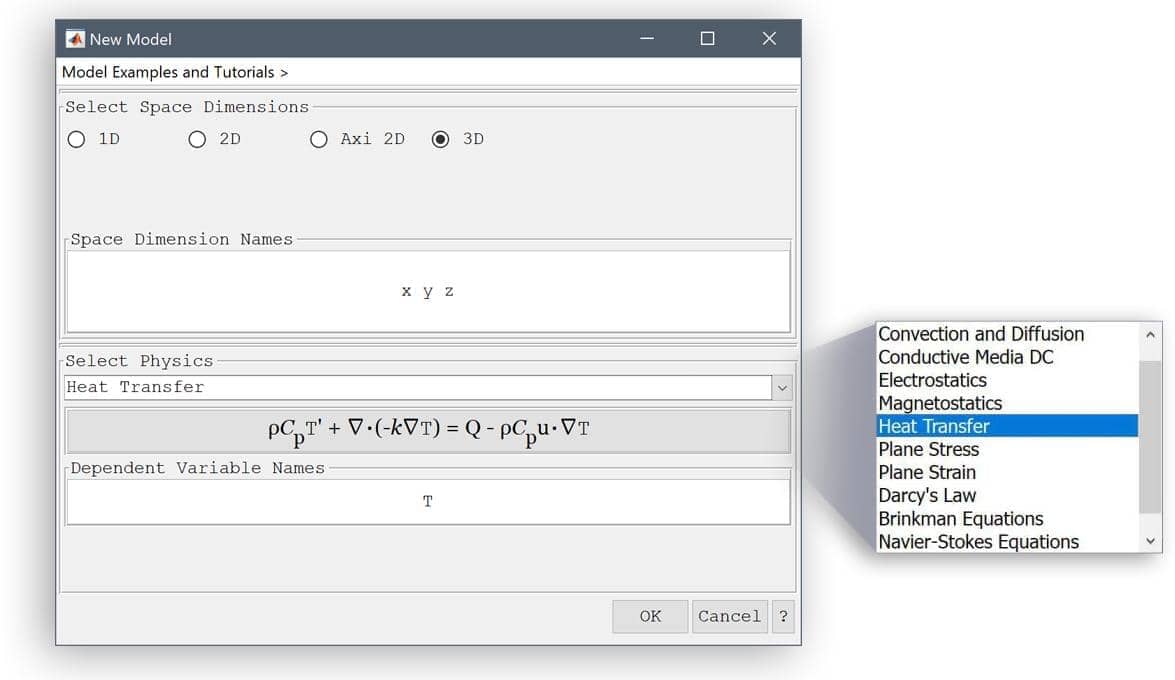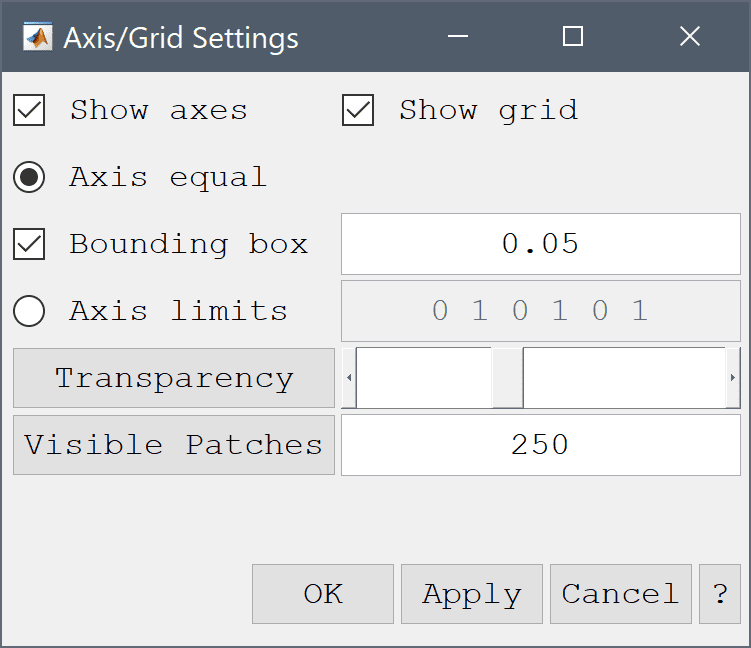
|
FEATool Multiphysics
v1.17.5
Finite Element Analysis Toolbox
|

|
FEATool Multiphysics
v1.17.5
Finite Element Analysis Toolbox
|
This section describes how to use the FEATool Graphical User Interface (GUI). Please note that the GUI may look different depending on your system configuration, FEATool and MATLAB versions.
After launching FEATool in MATLAB (by typing featool at the command prompt) the GUI will load. The main GUI window which will open is composed of the main GUI axes, top menu and toolbar, left vertical mode and tool button bars, and also command log and message windows. The functions of these GUI components are explained below.

The main GUI axes is where the geometry, computational grid, and postprocessing results are displayed. The camera view can be controlled by the Zoom In ![]() , Zoom Out
, Zoom Out ![]() , Pan
, Pan ![]() , and in 3D also the Rotate
, and in 3D also the Rotate ![]() , XY
, XY ![]() , , XZ
, , XZ ![]() , YZ
, YZ ![]() , Reset
, Reset ![]() , and Extents
, and Extents ![]() view buttons in the top toolbar.
view buttons in the top toolbar.
On the top of the GUI toolbar there are menus for file, options, mode, and help operations. The function of these menus are described in detail below
The File menu features the following options
The Options menu allows the axes and grid settings to be modified (these settings are described in the axes/grid settings section below).
The Geometry menu allows for switching to Geometry Mode, creating geometry objects (Create Object), Copy/Transform Objects..., and also accessing the Combine Objects... option which allows specification of more complex formulas for geometry object composition. 3D geometries support a 2D Workplane... to be created from which planar shapes can be extruded and revolved. Geometry export and import between FEATool geometry structs, BREP, IGES, OBJ, PLY, STL, and STEP CAD formats, as well as Gmsh (geo), and Triangle (poly), and bitmap image formats (BMP, JPG, PNG, TIFF) are also supported.
The Grid menu allows for switching to Grid Mode, Converting Grid Cells between triangular and quadrilateral cells in 2D, and between tetrahedral and hexahedral cells in 3D. View Subdomains... and View Boundaries... can be used to view resulting geometric entities and their corresponding numbering. A partial selection of mesh cells can also be shown with the View Selected Cells... menu option, while viewing and modifying meshed boundaries is done using Boundary Numbering.... Lastly, the Grid Statistics... option displays relevant stats for the mesh, such as the number of grid points, cells, and quality measures.
Grid Mode also supports import and export of grids through external files (and the main MATLAB workspace), these option can also be accessed from the Grid menu
The Equation and Boundary menus allows for switching to Equation/Boundary Modes and also opening the Equation/Boundary Settings... dialog boxes (see the equation andboundary" mode sections). Moreover, the Model Constant and Expressions... option allows for input of modeling variables and expressions that can be used in equations and boundary settings, and postprocessing. Point sources and constraints can also be added here with the corresponding Point Sources... and Point Constraints... menu options. In 3D the Edge Constraints... option is also available to add constraints on boundary edges. Physics modes can be removed with the Remove physics modes... option in the equation menu. In addition Boundary Integral Constraints... and Subdomain Integral Constraints... can also be applied.
The Solve menu similarly allows for switching to Solve Mode and also opening the Solver Settings... dialog box (these settings are described in the solver settings section). This menu also features an option to Get Initial Solution which computes the expressions defined in the equation settings Initial Condition fields and returns this as the solution.
The Post menu allows for switching to Postprocessing Mode, and opening the Plot Options... dialog box (see the postprocessing settings section below). In addition there are options for evaluating the minima and maxima for general expressions with Min/Max Evaluation..., points and line evaluation Point/Line Evaluation..., and integration of postprocessing expressions over subdomains Subdomain Integration... and boundaries Boundary Integration.... Animate/Playback Solution... allows for creating animations and videos of results, while Postprocessing Settings... enables changing settings such as smoothing of gradients. Moreover, the solution and postprocessing data can also be exported to be used with the Export Results... menu option in CSV, ParaView (VTK/VTP), and Webbrowser compatible file formats.
The Help menu can be used to access the FEATool Homepage..., online Documentation..., community and User Forum..., and open the About FEATool... information dialog box which shows licensing and version information. Selecting the System Info... menu option shows the current installed system and software components and their versions, and the Log File... of the current session can be viewed and saved by selecting the corresponding menu entry.
Activate License... is used to activate alicense", by entering an activation code or license key. Activated systems can be \ref install_deactivate "de-activated to move the license" to a new/different system, to do this select the Deactivate License... menu option.
The top GUI toolbar contains the following shortcut buttons (note that the GUI might show different options and icons depending on the MATLAB version used)
To the left of the main view axes is the mode toolbar which consists of six mode buttons which switches between the different modes
Below these buttons are the mode tool buttons which can change depending on which mode is selected.
Geometry Mode
Grid Mode
In grid mode the overall global maximum grid cell size variable hmax can be changed with the Grid Size edit field and slider in the grid tools toolbar.
Equation Mode
Boundary Mode
Solve Mode
Post Mode
Below the main GUI axes is the output terminal window which displays messages, and output from the local FEATool workspace such as information from grid generation and solvers. (Hold Ctrl + left click to save the command log window output.)
The message window can display hints and tips that might be useful to your simulation. While running tutorial GUI scripts (.fes files) the modeling steps will be displayed here. (Hold Ctrl + left click to save the message window output.)
Pressing the ![]() New Model toolbar button or selecting New Model... from the File menu opens the New Model dialog box.
New Model toolbar button or selecting New Model... from the File menu opens the New Model dialog box.

The first step in defining a new simulation model is to select the number of space dimensions to work in. The Select Space Dimensions frame allows one to choose from the 1D, 2D, Axisymmetry (for axisymmetric cylindrical coordinate systems), and 3D modeling spaces. Depending on which selection is made, the default Space Dimension Names (x, y, and z, or alternatively r and z in cylindrical coordinates) will be shown in the corresponding edit field. The space dimension variable names/labels can also be changed if desired, and are used by FEATool in defining equation, boundary, and postprocessing expressions.
The Select Physics drop down box shows a list of pre-defined physics and application modes available for the selected space dimension. By choosing one of the physics modes the corresponding physics equation and default Dependent Variable Names will be updated. This will be the first physics mode selected when defining a new model. Like the space dimension names, the dependent variable names can also be changed as long as they do not conflict with other variable names. The Custom Equation physics mode allows for any number of dependent variables to be entered. Additional physics modes can be added later by using the + tab in the Equation Settings dialog box in Subdomain Mode, as described the Multiphysics section.
To finish the initial selection process and start a new model press OK, or press Cancel to return to the previous model. Alternatively, the step-by-step tutorial models can also be started by selecting one in the top Model Examples and Tutorials... menu.
Equation, Boundary, Solve, and Postprocessing mode usage and corresponding dialog boxes are described in the following sections.
The Axis/Grid Settings dialog box features user controls for modifying the viewing plot and visualization axes. The Show axes and Show grid options can be used to show or hide the grid and axes. Axis equal enables that the axes directions have equal lengths to each other (in the x, y, and z-directions), when enabled a Bounding box can be used to add additional (relative) space with respect to the bounding box of the geometry (default 5%). Alternatively, one can also prescribe the Axis limits manually.
In 3D a slider control also allows setting of the Transparency (opacity) level of the objects. Moreover, a maximum number of Visible patches to plot when redrawing can be specified. If the total number of patches exceeds this, only the geometry outlines will be rendered during view operations (pan, zoom, rotation) in order to increase and improve potentially slow responsiveness for model with a large number of objects.

The following keyboard shortcuts are available in FEATool
Moreover, in 2D Geometry mode one can hold down a Shift key while using the Create circle/ellipse tool to restrict to a circular geometry instead of allowing elliptical ones.